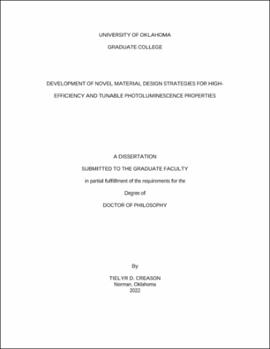| dc.description.abstract | New developments in the understanding of structural-optical property relationships of optoelectronic materials have led to rapid growth in energy-efficient solid-state lighting technologies. These improvements in the field of inorganic materials chemistry have led to new products, such as light-emitting diodes (LEDs) for residential lighting, scintillators for radiation detection, and luminescent inks for anti-counterfeiting applications. The emergence of lead halide perovskites has led to a paradigm shift in this area, with many groups around the globe working on both fundamental properties and practical applications of this diverse family. An unexplored alternative to the toxic nature of lead halides is the recently discovered families of earth-abundant and non-toxic copper(I) and silver halides. The structural-optical property relationships and physical properties of these new materials must be elucidated to continue development. This work focuses on understanding the optoelectronic properties of copper(I) and silver halides. The work also explores the strategy of utilizing organic cations as the source of emission, as opposed to more popular reliance on the metal halide polyhedra.
To better understand the history and fundamental science, the work begins with an introduction to down-converting metal halides in chapter 1. The information presented in the first chapter directly applies to the following chapter, as chapter 2 continues by investigating A2CuX3 (A= K, Rb and X= Cl, Br), a family of bright blue photoluminescent compounds with up to unity absolute photoluminescent quantum yield. A series of optical measurements were completed in order to thoroughly examine the effects of elemental substitution. The optical measurements were also supported with additional chemical purity and environmental stability test. The emission mechanism in these materials is established through a combination of spectroscopic and computational studies.
While the all-inorganic copper(I) halides answered some questions, many more were asked upon completion of the work. To further explore the impact of substituting the metal center, chapter 3 dives into the analogous silver halides in hopes of better understanding the varying emission mechanisms that can exist in these systems. These compounds display tunable, white emission, in stark contrast to their copper(I) counterparts. A broader elemental substitution study was conducted to understand the role of vacancies in the system. The work progressed beyond fundamental material design and continued into preliminary application research.
While extensive investigations of crystal and electronic structures and optical properties of all-inorganic group 11 metal halides have been conducted, a vast family of hybrid Cu(I) and Ag(I) materials remains unexplored. The last research component, chapter 4, changes directions away from metal-derived emission and explores the area of organic-derived emission. Although many organic compounds are known to be efficient light emitters, they are often unstable for practical application considerations. This work evaluates a novel method to stabilize and improve the photoluminescent emission while maintaining the same emission profile. The work opens the door to more hybrid organic-inorganic emitters. To tie everything together, chapter 5 concludes the work and discusses future directions. | en_US |
